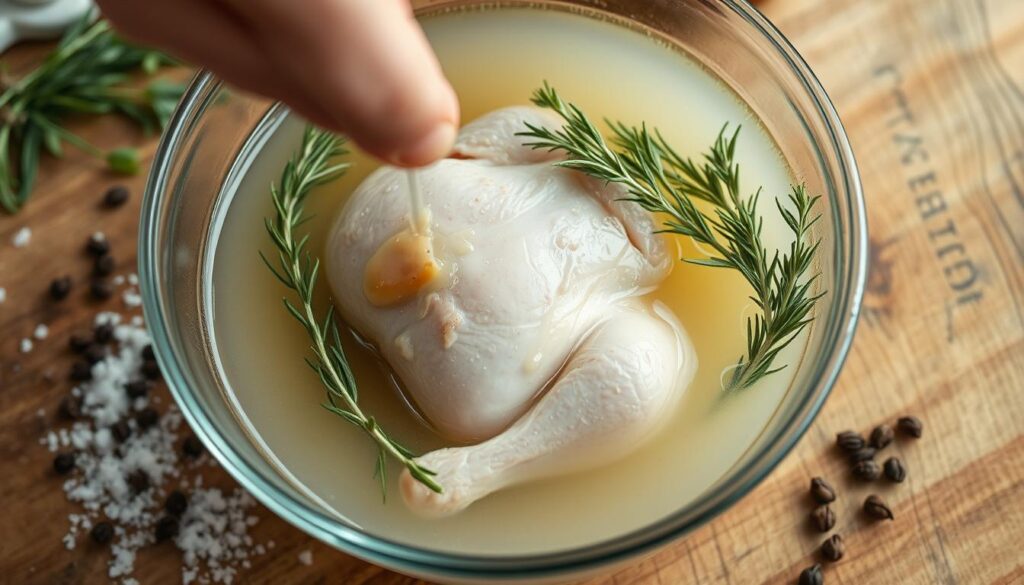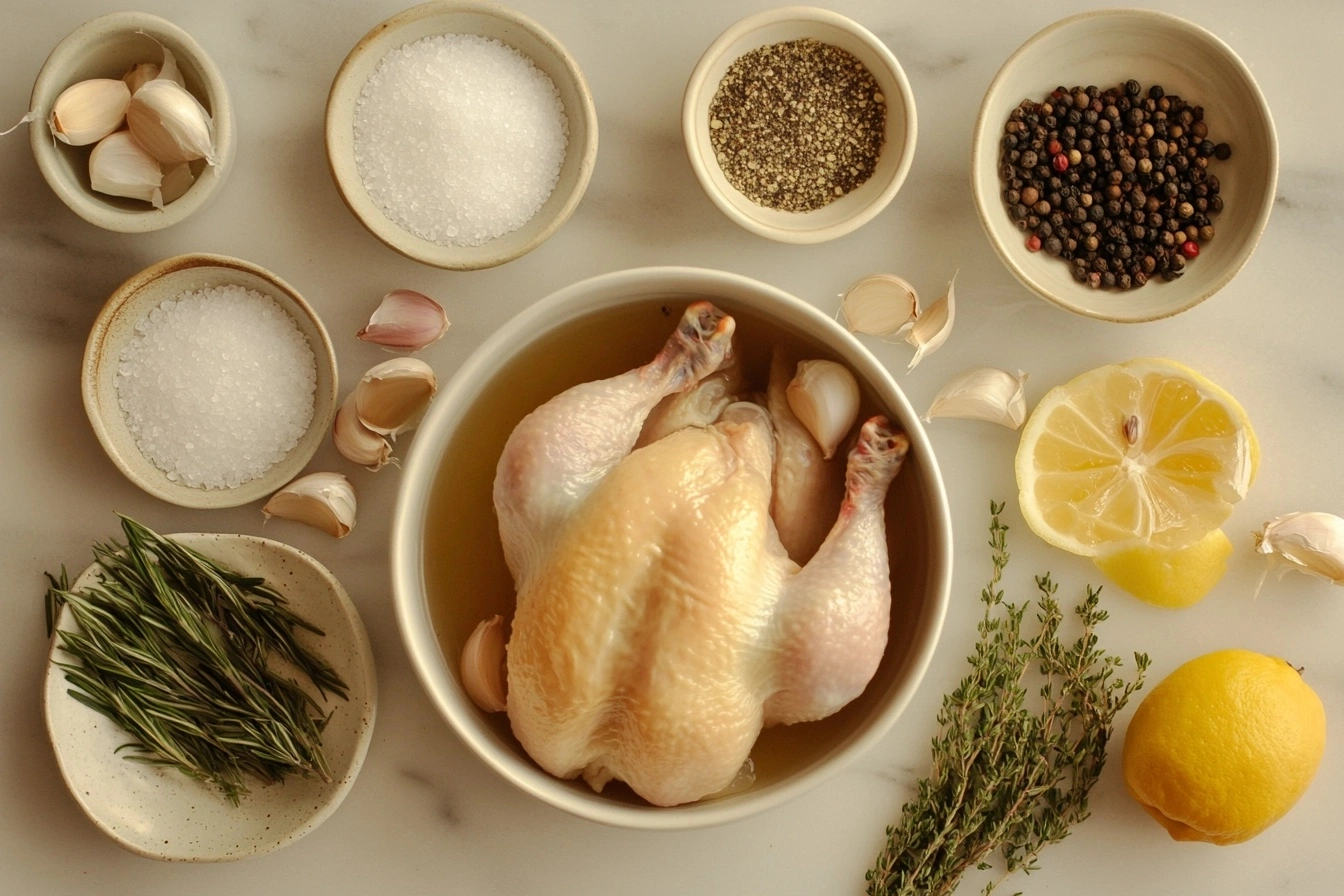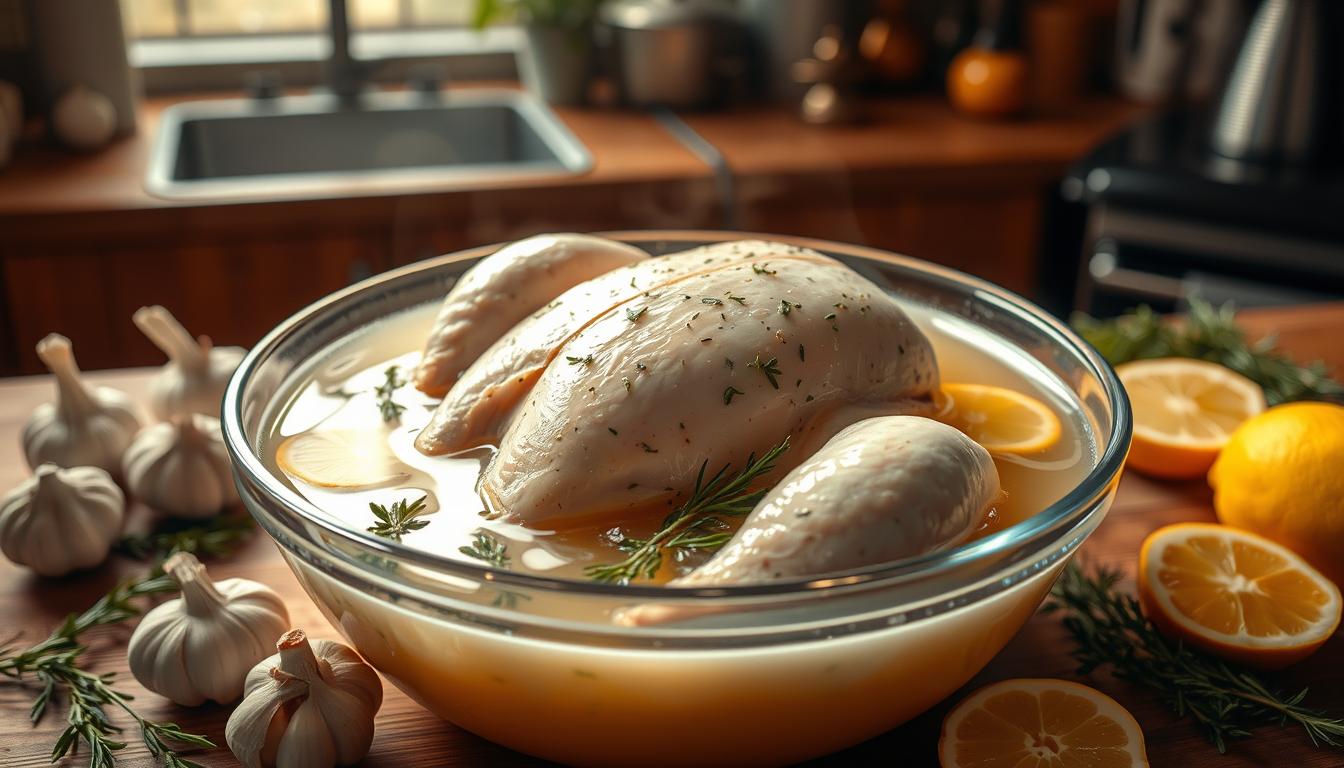Brining chicken is a simple yet effective way to keep your poultry juicy and flavorful. But How long should chicken sit in brine? The answer varies based on several factors, like the chicken’s size and cut, and the brine’s ingredients. In this article, we’ll explore the science behind chicken brining and give you guidelines for the perfect brining time.
Key Takeaways
- Brining involves soaking chicken in a saltwater solution to enhance moisture and flavor.
- The optimal brining time can vary from 30 minutes to 24 hours, depending on the chicken cut and brine recipe.
- Factors like salt concentration, temperature, and chicken thickness affect the ideal brining duration.
- Properly brined chicken will be juicier, more tender, and better seasoned throughout.
- Monitoring the brining process and adjusting time as needed is crucial for achieving the best results.
Understanding the Science of Chicken Brining
Brining has been around for centuries to make meats like chicken taste better and feel softer. But how does it work, and why is it good for chicken? Let’s explore the science behind this amazing technique.
What is Brining and How Does it Work?
Brining means soaking chicken in a saltwater mix for a while. This lets the salt get into the meat, changing its structure and chemistry in important ways:
- Salt breaks down chicken proteins, making it tender and juicy.
- The chicken absorbs moisture from the brine, making it more succulent and tasty.
- Brining helps chicken keep its juices during cooking, so it doesn’t dry out.
Benefits of Brining Chicken
Brining’s science shows why it’s a favorite for cooking chicken. The main benefits are:
- Improved Texture: Salt and moisture make chicken breasts tender and juicy.
- Enhanced Flavor: Brining lets chicken soak up seasonings, making dishes more flavorful.
- Reduced Drying: Extra moisture stops chicken from drying out when cooked.
Brining changes chicken’s texture and taste, making it a favorite among cooks. Knowing how it works opens up new flavors for your chicken dishes.

Factors Affecting Chicken Brining Time
Brining chicken can take different times based on several important factors. Knowing these can help you get the right flavor and texture. Let’s look at the main factors affecting brining time and how to adjust for them.
The size and thickness of the chicken cuts are key. Larger, thicker pieces need more time for the brine to soak in. Smaller, thinner cuts like tenders might only need a short soak.
- As a general rule, allow 30 minutes to 1 hour of brining time per pound of chicken.
- Adjust the time based on the specific cuts you’re working with.
The temperature of the brine solution also matters. Warmer brine solutions soak in faster. Cooler brines take longer.
- For best results, brine your chicken in a refrigerator-chilled brine between 34°F and 40°F.
- If brining at room temperature, reduce the time by 25-50% to avoid over-brining.
The concentration of the brine solution is also important. A stronger brine soaks in faster than a weaker one. Changing the brine strength can help adjust the brining time.
“The key to mastering brined chicken is understanding how these variables work together to impact the optimal soak time. By paying attention to these factors, you can create a perfectly seasoned and juicy bird every time.”
By understanding these factors affecting brining time, you can adjust the brining duration. This knowledge will help you make delicious, well-seasoned chicken every time you brine.

The Ideal Brining Time for Chicken
Getting the perfect flavor and juiciness in chicken is all about brining time. The right brining time depends on the chicken cut. Here are some tips to help you get it right.
Brining Time for Different Chicken Cuts
- Chicken Breasts: 30 minutes to 1 hour
- Chicken Thighs: 1 to 4 hours
- Whole Chicken: 4 to 8 hours
Thicker chicken cuts need longer brining times. Chicken breasts, being lean, brine for 30 minutes to 1 hour. A whole chicken, with its varied thickness, brines for 4 to 8 hours to soak up flavor and moisture evenly.
| Chicken Cut | Ideal Brining Time |
|---|---|
| Chicken Breasts | 30 minutes to 1 hour |
| Chicken Thighs | 1 to 4 hours |
| Whole Chicken | 4 to 8 hours |
These times are just a starting point. The best brining time can change based on chicken size, thickness, and your recipe. Feel free to experiment to find what works best for you.
How to Know When Your Chicken is Properly Brined
Brining chicken is an art that requires knowing when it’s done right. You need to look for signs that show your chicken is seasoned and moist. These signs help make sure your chicken is both tasty and juicy, whether you’re roasting or grilling it.
The look of your chicken is a key indicator. When chicken is brined, it looks plumper and more vibrant. The skin might also look shinier, showing it has absorbed more moisture.
How the chicken feels is also important. Well-brined chicken feels tender and juicy. It’s springier to the touch than unbrined chicken. The skin should be crispy but not dry when cooked.
The taste of the chicken is the best way to know if it’s brined right. The meat should taste evenly seasoned. It should have a mix of savory, salty, and sweet or herbal flavors. The taste should be richer and more balanced than unbrined chicken.
Remember these signs to know when your chicken is perfectly brined. This ensures your roast or grilled chicken is always delicious and juicy.
How Long Should Chicken Sit in Brine?
Brining chicken is all about the right brining time. How long you let the chicken soak in the brine affects its texture, flavor, and moisture. It’s a key factor to get right.
The recommended brining time for chicken varies. It can be anywhere from 30 minutes to 24 hours, depending on the cut and recipe. But, don’t let it soak for more than 24 hours. Too long can make the chicken too salty and tough.
Here’s a guide for different chicken cuts:
- Chicken breasts: 30 minutes to 4 hours
- Chicken thighs and drumsticks: 1 to 6 hours
- Whole chicken: 4 to 12 hours
The how long to soak chicken in brine can change based on several things. These include the meat’s thickness, the brine’s saltiness, and how seasoned you want it. Adjusting the brining time can help get your chicken just right.
“The key to perfectly brined chicken is finding the right balance between time and flavor. Experiment with different brining durations to achieve your desired results.”
Remember, the recommended brining time for chicken isn’t the same for everyone. It depends on your taste, the recipe, and the chicken’s type. Find the perfect how long to soak chicken in brine for your needs.
Preparing the Brine Solution
Making the perfect brine is key to juicy, flavorful chicken. You need a few ingredients and the right mix. Knowing the science of brining lets you adjust the brine to your taste. This ensures your chicken is full of flavor.
Essential Ingredients and Ratios
A basic brine for chicken includes salt, sugar, and water. The best brine ratio is 1/4 cup of salt and sugar for every 4 cups of water. This mix keeps the chicken moist and adds a hint of sweetness and flavor.
You can also add herbs, spices, and aromatics to make your brine unique. Some favorites are:
- Peppercorns
- Bay leaves
- Garlic cloves
- Fresh herbs like rosemary, thyme, or parsley
- Lemon or orange zest
It’s important to find a brine ratio that you like. Adjust the salt and sugar to get the flavor and moisture just right.
| Ingredient | Ratio |
|---|---|
| Salt | 1/4 cup per 1 quart of water |
| Sugar | 1/4 cup per 1 quart of water |
| Water | 4 cups (1 quart) |
“The key to a perfectly brined chicken is finding the right balance between salt, sugar, and water. Experiment with different ratios to discover your ideal brine solution.”
Safety Considerations for Brining Chicken
When brining chicken, food safety is key. You need to handle the chicken right and prevent illness. Brining can make chicken taste better and stay moist, but safety comes first.
Keeping the brine at the right temperature is crucial. It should be between 40°F and 140°F to stop harmful bacteria. Always check the brine and chicken temperatures and throw away chicken that’s too warm.
- Always refrigerate brined chicken, both during the brining process and after it has been removed from the brine.
- Avoid leaving brined chicken at room temperature for more than 2 hours, or 1 hour if the temperature is above 90°F.
- Use a food thermometer to ensure the brine and brined chicken are within the safe temperature range.
Good food handling is also vital. Use clean tools and wash your hands well. This stops germs from spreading.
| Best Practices for Brining Chicken Safely | Potential Consequences of Improper Handling |
|---|---|
|
|
By following these food safety guidelines for brining chicken, you can enjoy brining safely. Proper food handling for brining and preventing foodborne illness when brining are key for a great brining experience.
Creative Brine Flavor Combinations
Brining chicken makes it taste better and stay juicy. But why stick to just one flavor? Try out new and tasty brine mixes to excite your taste buds.
Discover flavored chicken brine and unique brine recipes to boost your chicken cooking. Mix aromatic herbs with exciting spices for endless creative brining ideas.
Herb-Infused Brines
- Rosemary and Thyme: A classic mix that adds a woodsy, fragrant taste to your chicken.
- Basil and Lemon: A bright and refreshing mix that brightens the flavor.
- Garlic and Oregano: A savory blend that gives your chicken a Mediterranean twist.
Spice-Infused Brines
- Chipotle and Lime: A smoky and tangy brine that adds a kick of heat to your chicken.
- Ginger and Soy: A umami-rich mix that gives an Asian-inspired flavor.
- Cajun Spice Blend: A bold and flavorful brine that brings the Bayou’s heat and zest.
Feel free to try out different flavored chicken brine mixes. The goal is to find the right balance of flavors that enhance the chicken’s natural taste. With a bit of creativity and boldness, you can create unique brine recipes and creative brining ideas that will make everyone want more.
| Brine Flavor | Pairing Suggestions |
|---|---|
| Rosemary and Thyme | Roasted potatoes, grilled vegetables |
| Basil and Lemon | Fresh salads, grilled fish |
| Chipotle and Lime | Grilled corn, black beans |
Brining Techniques for Whole Chickens
Brining a whole chicken might seem hard, but with the right steps, you can get great results. It’s perfect for a Sunday roast or a big holiday meal. Learning to brine a whole chicken can really change your cooking game.
Tips for Even Brining
Here are some tips to help you brine evenly:
- Choose a big container to fully cover the chicken. This ensures the brine touches every part.
- Flip the chicken a few times while it’s brining. This helps the brine soak into the meat better.
- Try injecting the brine into the chicken’s thickest parts, like the breasts and thighs. This boosts flavor.
- Brine the chicken with its breast down. This lets the brine soak into the meat more.
- Keep the brine’s temperature between 35°F and 40°F. This stops bacteria from growing.
Using these methods will help you how to brine a whole chicken perfectly. You’ll get a bird that’s juicy and full of flavor every time.
| Brining Technique | Benefits |
|---|---|
| Fully submerging the chicken | Allows the brine to reach every part of the bird for even seasoning |
| Flipping the chicken periodically | Promotes more thorough brine absorption into the meat |
| Injecting brine directly into the thickest areas | Ensures maximum flavor penetration for juicier, more flavorful results |
| Brining the chicken breast-side down | Allows the brine to better permeate the meat |
| Maintaining the proper brining temperature | Prevents bacterial growth and ensures food safety |
By using these brining techniques for whole chickens, you’ll get even brining. You’ll make your meals taste like they’re from a restaurant.
Troubleshooting Common Brining Issues
Brining chicken can make it incredibly juicy and flavorful. But, it can also lead to a few common problems. These include over-brining and flavor imbalances. Luckily, there are simple ways to fix these issues.
Over-brining makes chicken too salty and dense. To fix this, soak the meat in fresh water for 30 minutes to an hour. This helps remove excess salt. If the chicken is under-brined, try soaking it longer or use more salt in the brine next time.
Flavor imbalances can also happen. The brine might overpower the chicken’s natural taste or not add enough flavor. To solve this, adjust the salt, sugar, and aromatics in the brine. You can also add more herbs, spices, or fruit juices for a stronger taste.
